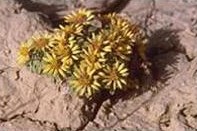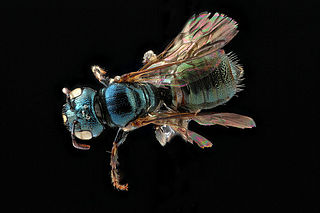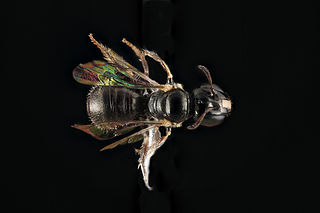
Ptelea trifoliata, commonly known as common hoptree, wafer ash, stinking ash, and skunk bush, is a species of flowering plant in the citrus family (Rutaceae). It is native to North America, where it is found in Canada, Mexico, and the United States. It is a deciduous shrub or tree, with alternate, trifoliate leaves.

The cosmopolitan bee genus Ceratina, often referred to as small carpenter bees, is the sole lineage of the tribe Ceratinini, and is not closely related to the more familiar carpenter bees. The genus presently contains over 300 species in 23 subgenera. They make nests in dead wood, stems, or pith, and while many are solitary, a number are subsocial, with mothers caring for their larvae, and in a few cases where multiple females are found in a single nest, daughters or sisters may form very small, weakly eusocial colonies. One species is unique for having both social and asocial populations, Ceratina australensis, which exhibits all of the pre-adaptations for successful group living. This species is socially polymorphic with both solitary and social nests collected in sympatry. Social colonies in that species consist of two foundresses, one contributing both foraging and reproductive effort and the second which remains at the nest as a passive guard. Cooperative nesting provides no overt reproductive benefits over solitary nesting in this population, although brood survival tends to be greater in social colonies. Maternal longevity, subsociality and bivoltine nesting phenology in this species favour colony formation, while dispersal habits and offspring longevity may inhibit more frequent social nesting in this and other ceratinines.

Townsendia aprica is a rare species of flowering plant in the family Asteraceae known by the common name Last Chance Townsend daisy. It is endemic to Utah in the United States, where it is known from three counties. It faces a number of threats and it is a federally listed threatened species of the United States.

Ribes americanum is a North American species of flowering plant in the gooseberry family known as wild black currant, American black currant, and eastern black currant. It is widespread in much of Canada and the northern United States.
Ceratina hieroglyphica, is a species of bee belonging to the family Apidae, subfamily Xylocopinae. It makes its nest out of twigs of multiple plant species, including Anacardium occidentale and Caesalpinia pulcherrima.

Ceratina strenua, the nimble ceratina, is a species of small carpenter bee in the family Apidae. It is found in North America.
Anthaxia nanula is a species of metallic wood-boring beetle in the family Buprestidae. It is found in North America.

Ceratina cobaltina is a species of small carpenter bee in the family Apidae. It is found in Central America.
Rhagonycha nanula is a species of soldier beetle in the family Cantharidae. It is found in North America.

Ceratina cockerelli is a species of small carpenter bee in the family Apidae. It is found in the Caribbean Sea and North America.
Micracisella is a genus of typical bark beetles in the family Curculionidae. There are at least 20 described species in Micracisella.

Ceratina arizonensis is a species of small carpenter bee in the family Apidae. It is found in Central America and North America.

The cloudy-winged miner bee is a species of miner bee in the family Andrenidae. It is found in Central America and North America.

Ceratina calcarata, the spurred ceratina, is a species of small carpenter bee in the family Apidae. It is found in eastern North America. This species ranges from Georgia, USA north to Ontario, Canada and east to Nova Scotia, Canada. This bee is a common generalist, native pollinator, it pollinates plants like watermelon and cucumber very effectively. C. calcarata adds to the productivity of a wide range of ecological and agricultural systems due to its wide range and abundance. This small bee is becoming a model organism in the scientific research of social evolution. C. calcarata is the first subsocial bee species to have its genome published, allowing researchers to investigate the evolutionary origins of social behaviour.
Ceratina sequoiae is a species of small carpenter bee in the family Apidae. It is found in North America. It is a specialist on Clarkia flowers.
Ceratina dallatorreana is a species of small carpenter bee in the family Apidae. It is found in Africa, Europe and Northern Asia, and North America.

Ceratina acantha is a species of small carpenter bee in the family Apidae. It is found in Central America and North America. These bees nest in dead twigs.

Ceratina dupla, the doubled ceratina, is a species of small carpenter bee in the family Apidae. It is found in the eastern half of North America. It was formerly confused with the species Ceratina floridana and Ceratina mikmaqi, until molecular analyses demonstrated significant genetic differences between the taxa.

Pemphredon lethifer is a Palearctic species of solitary wasp. It prefers to make nests using large twigs from the genus Sambucus.












